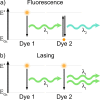Transparent Wood Biocomposite of Well-Dispersed Dye Content for Fluorescence and Lasing Applications
- PMID: 37255504
- PMCID: PMC10226163
- DOI: 10.1021/acsaom.3c00100
Transparent Wood Biocomposite of Well-Dispersed Dye Content for Fluorescence and Lasing Applications
Abstract
Aggregation-induced quenching often restricts emissive performance of optically active solid materials with embedded fluorescent dyes. Delignified and nanoporous wood readily adsorbs organic dyes and is investigated as a host material for rhodamine 6G (R6G). High concentration of R6G (>35 mM) is achieved in delignified wood without any ground-state dye aggregation. To evaluate emissive performance, a solid-state random dye laser is prepared using the dye-doped wood substrates. The performance in terms of lasing threshold and efficiency was improved with increased dye content due to the ability of delignified wood to disperse R6G.
© 2023 The Authors. Published by American Chemical Society.
Conflict of interest statement
The authors declare no competing financial interest.
Figures




Similar articles
-
Influence of an Interfacial Effect on the Laser Performance of a Rhodamine 6G/Cellulose Acetate Waveguide on a Vinylidene Fluoride Copolymer Layer.Langmuir. 2018 Jun 26;34(25):7527-7535. doi: 10.1021/acs.langmuir.8b01107. Epub 2018 Jun 12. Langmuir. 2018. PMID: 29806775
-
Reconfigurable Solid-state Dye-doped Polymer Ring Resonator Lasers.Sci Rep. 2015 Dec 17;5:18310. doi: 10.1038/srep18310. Sci Rep. 2015. PMID: 26674508 Free PMC article.
-
Highly fluorescent colloids based on rhodamine 6G, modified layered silicate, and organic solvent.J Colloid Interface Sci. 2012 Dec 15;388(1):15-20. doi: 10.1016/j.jcis.2012.08.020. Epub 2012 Aug 24. J Colloid Interface Sci. 2012. PMID: 22995248
-
Enhanced Luminescence of Dye-Decorated ZIF-8 Composite Films via Controllable D-A Interactions for White Light Emission.Langmuir. 2023 Mar 14;39(10):3656-3667. doi: 10.1021/acs.langmuir.2c03299. Epub 2023 Mar 1. Langmuir. 2023. PMID: 36856700
-
Transparent wood for functional and structural applications.Philos Trans A Math Phys Eng Sci. 2018 Feb 13;376(2112):20170182. doi: 10.1098/rsta.2017.0182. Philos Trans A Math Phys Eng Sci. 2018. PMID: 29277747 Free PMC article. Review.
References
-
- Chen S.; Lin C.; Cheng T.; Tseng W. 6-Mercaptopurine-Induced Fluorescence Quenching of Monolayer MoS2 Nanodots: Applications to Glutathione Sensing, Cellular Imaging, and Glutathione-Stimulated Drug Delivery. Adv. Funct. Mater. 2017, 27, 1702452.10.1002/adfm.201702452. - DOI
-
- Baldo M. A.; O’Brien D. F.; You Y.; Shoustikov A.; Sibley S.; Thompson M. E.; Forrest S. R. Highly efficient phosphorescent emission from organic electroluminescent devices. Nature 1998, 395, 151–154. 10.1038/25954. - DOI
-
- Gerega A.; Milej D.; Weigl W.; Botwicz M.; Zolek N.; Kacprzak M.; Wierzejski W.; Toczylowska B.; Mayzner-Zawadzka E.; Maniewski R.; Liebert A. Multiwavelength time-resolved detection of fluorescence during the inflow of indocyanine green into the adult’s brain. J. Biomed. Opt. 2012, 17, 087001.10.1117/1.jbo.17.8.087001. - DOI - PubMed
-
- Duarte F. J. Tunable organic dye lasers: Physics and technology of high-performance liquid and solid-state narrow-linewidth oscillators. Prog. Quant. Electron. 2012, 36, 29–50. 10.1016/j.pquantelec.2012.03.002. - DOI
LinkOut - more resources
Full Text Sources
